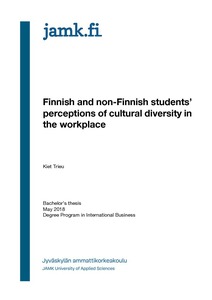Finnish and non-Finnish students’ perceptions of cultural diversity in the workplace
TRIEU, KIET (2018)
TRIEU, KIET
Jyväskylän ammattikorkeakoulu
2018
All rights reserved
Julkaisun pysyvä osoite on
https://urn.fi/URN:NBN:fi:amk-2018081714557
https://urn.fi/URN:NBN:fi:amk-2018081714557
Tiivistelmä
According to Statistics Finland (2015), every tenth person in Finland aged 25 to 44 is of foreign background, six percent of the Finnish population living permanently in the country speak a foreign language as their native tongue, and 32.150 migrants applied for asylum in Finland in 2015. Given this high number of foreign-born residents in Finland, the study objectives were to determine the Finnish and non-Finnish students’ perceptions of cultural diversity in the workplace and whether different demographical traits generate disparity in perceptions.
A qualitative research approach was adopted wherein a structured asynchronous email interview was used as the data collection method in order to investigate a sample of twelve participants who are or were recently university students in Finland. The sample is diverse in terms of nationality, gender, the language of instruction at school, education, and diversity exposure. The data were analyzed inductively through content analysis and a constant comparative method.
The research results suggest that sampled students’ perceptions of cultural diversity in the Finnish workplace are evident in (a) their belief in ‘synergy facilitation’ as a primal force to promote diversity in the Finnish workplace, (b) their acknowledgement of the existing burdens that block cultural diversity from thriving, and (c) their suggestion for improved diversity management processes that are tailored for Finland. The perceptions differentiate the most by nationality and diversity exposure level. Those who seek theoretical and practical knowledge about cultural diversity in Finland through the eyes of university students in Finland may benefit from this research.
A qualitative research approach was adopted wherein a structured asynchronous email interview was used as the data collection method in order to investigate a sample of twelve participants who are or were recently university students in Finland. The sample is diverse in terms of nationality, gender, the language of instruction at school, education, and diversity exposure. The data were analyzed inductively through content analysis and a constant comparative method.
The research results suggest that sampled students’ perceptions of cultural diversity in the Finnish workplace are evident in (a) their belief in ‘synergy facilitation’ as a primal force to promote diversity in the Finnish workplace, (b) their acknowledgement of the existing burdens that block cultural diversity from thriving, and (c) their suggestion for improved diversity management processes that are tailored for Finland. The perceptions differentiate the most by nationality and diversity exposure level. Those who seek theoretical and practical knowledge about cultural diversity in Finland through the eyes of university students in Finland may benefit from this research.
